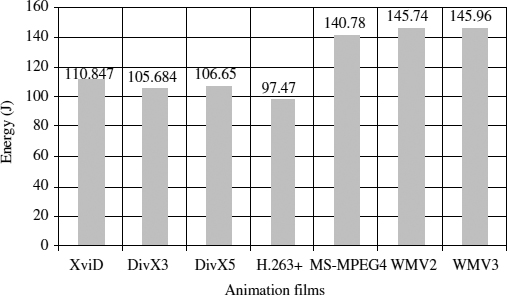23.4 EXPERIMENT RESULTS
We investigate energy efficiency of video decoding on the handheld devices by various video encoding scenarios. We measured energy consumption of video encoded (a) by various types of codecs in experiment 1, (b) in various video file formats, and (c) by changing coding parameters: the bit rate, the frame rate, and the resolution one by one.
23.4.1 Experiment 1
We used XviD, DivX3 (open source version), DivX5, MS MPEG-4 V2, H.263+, WMV2, and WMV3 as codecs to encode the films, five video clippings for each genres. The output formats were in AVI. We replayed the video clippings on the PDA and measured the energy consumption. Plots of the average energy consumptions in Joules for the five video clippings versus various codecs are shown in Figure 23.5 for the animation films, in Figure 23.6 for the action thrillers, and in Figure 23.7 for the romance films.
From these three energy consumption plots, we observe that energy consumptions of films encoded by XviD, DivX3, DivX5, and H.263+ are similar, and those encoded by MS MPEG-4 V2, WMV2, and WMV3 are similar. We also observe that the films encoded by XviD, DivX3, DivX5, and H.263+ consume less electricity than those encoded by MS MPEG-4, WMV2, and WMV3.

Figure 23.5 Average energy consumption (unit in Joules) of animation films encoded with various codecs: XviD, DivX3, DivX5, H.263+, MS MPEG-4, WMV2, and WMV3. ...
Get Mobile Intelligence now with the O’Reilly learning platform.
O’Reilly members experience books, live events, courses curated by job role, and more from O’Reilly and nearly 200 top publishers.

